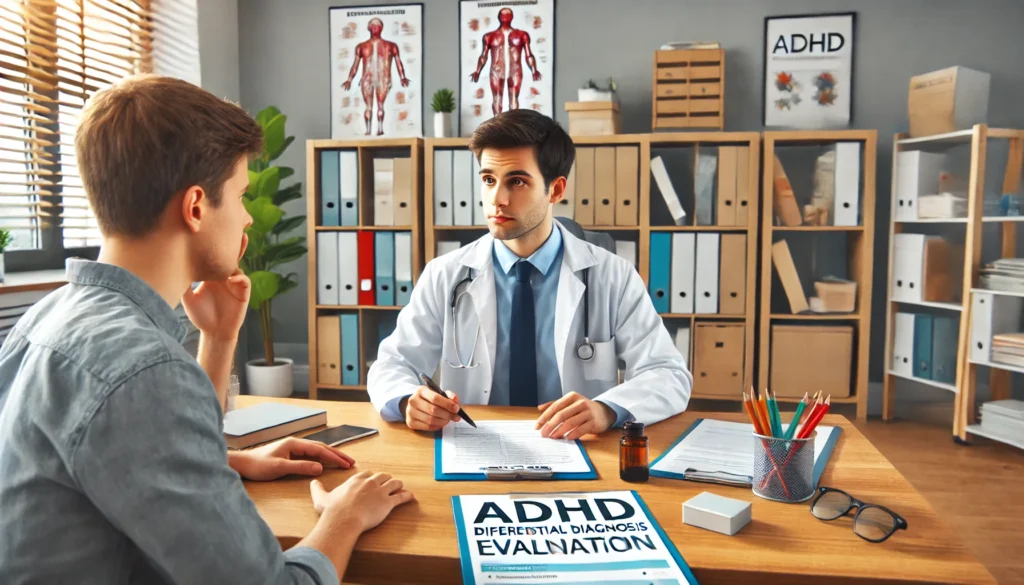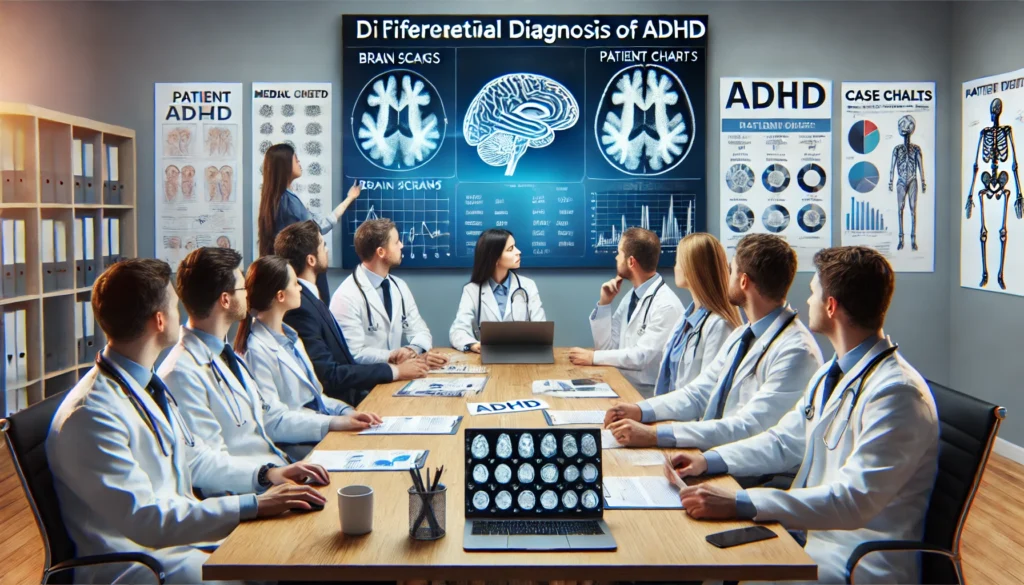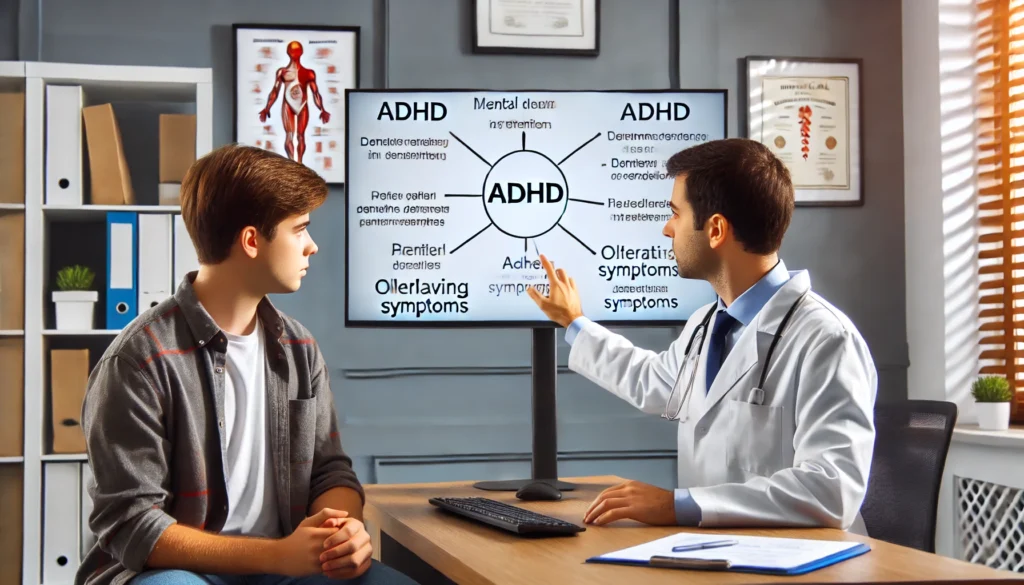Attention-Deficit/Hyperactivity Disorder (ADHD) is a complex and often misunderstood condition that affects millions worldwide. Despite its prevalence, the path to a proper diagnosis can be fraught with challenges. This article delves into the intricacies of ADHD identification, focusing on the hurdles of differential diagnosis.
You may also like: Enhancing Concentration: Strategies for ADHD
Understanding ADHD
ADHD is characterized by symptoms such as inattention, hyperactivity, and impulsivity. However, these symptoms can overlap with other mental health disorders, making accurate diagnosis challenging. A thorough understanding of ADHD’s nuances is crucial for healthcare professionals, wellness coaches, and anyone involved in mental health advocacy.
Historical Perspective
The concept of ADHD has evolved significantly over the years. Initially recognized as “minimal brain dysfunction” in the early 20th century, the understanding of ADHD has expanded with advances in neuroscience and psychology. Today, ADHD is recognized as a neurodevelopmental disorder, with genetic, environmental, and neurological factors contributing to its manifestation.
Early Terminology and Misunderstandings
Initially, ADHD was not well understood, and early terminology reflected this confusion. Terms like “hyperkinetic reaction of childhood” were used, which often led to misinterpretations of the disorder as merely behavioral issues rather than a neurodevelopmental condition. This lack of understanding contributed to stigma and inadequate treatment approaches.
Evolution of Diagnostic Criteria
Over the decades, diagnostic criteria for ADHD have evolved to become more precise. The introduction of standardized diagnostic manuals like the DSM has helped in outlining specific criteria for ADHD, aiding in more consistent and accurate diagnoses. These criteria have been refined over successive editions, reflecting growing scientific insights.
Impact of Neuroscience Advances
The field of neuroscience has played a pivotal role in transforming our understanding of ADHD. Brain imaging studies have highlighted structural and functional differences in the brains of those with ADHD, providing a biological basis for the disorder. These advances have helped shift perceptions from ADHD being merely a behavioral issue to a recognized medical condition.
Current Trends in ADHD Diagnosis
Recent trends emphasize early identification and intervention. This shift is driven by an increased awareness of the disorder’s impact on individuals’ academic, social, and occupational performance. However, the rise in ADHD diagnoses has also sparked debates about over-diagnosis and the potential for misidentification.
Increasing Awareness and Early Intervention
The modern approach to ADHD underscores the importance of recognizing symptoms early in life. Schools and pediatricians are now more vigilant in spotting potential signs of ADHD, enabling earlier interventions. Early diagnosis can lead to more effective management strategies, which are crucial for improving long-term outcomes.
The Over-Diagnosis Debate
With the rise in ADHD diagnoses, concerns have emerged regarding potential over-diagnosis. Critics argue that normal childhood behaviors are sometimes labeled as ADHD, leading to unnecessary medication. This debate highlights the need for careful assessment and adherence to diagnostic criteria to avoid misdiagnosis.
Cultural and Societal Influences
Cultural and societal factors play a significant role in ADHD diagnosis rates. In some cultures, hyperactivity and impulsivity might be viewed differently, affecting how ADHD is perceived and diagnosed. Understanding these influences is crucial for developing culturally sensitive diagnostic and treatment approaches.

The Challenge of Differential Diagnosis
Differential diagnosis is the process of distinguishing ADHD from other conditions with similar symptoms. This is a critical step in ensuring that individuals receive appropriate treatment and support.
Overlapping Symptoms
Many disorders share symptoms with ADHD, including anxiety, depression, autism spectrum disorders, and learning disabilities. For example, both ADHD and anxiety can manifest as restlessness and difficulty concentrating. This overlap necessitates a comprehensive evaluation to pinpoint the exact cause of symptoms.
ADHD vs. Anxiety
Anxiety disorders can mimic ADHD symptoms, such as restlessness and difficulty concentrating. Differentiating between the two requires understanding the context and triggers of these symptoms. Clinicians must assess whether symptoms are driven by an underlying anxiety disorder or if they are part of the ADHD profile.
ADHD and Depression
Depression can also present challenges in differential diagnosis. While ADHD is characterized by hyperactivity, depression might present as lethargy and lack of motivation. However, the inattention seen in both conditions can blur the lines, requiring careful evaluation of mood and behavioral patterns.
Autism Spectrum Disorders and ADHD
Autism spectrum disorders (ASD) and ADHD often co-occur, but they are distinct conditions. Both may exhibit social challenges and impulsivity, yet ASD involves more profound communication and social interaction difficulties. Clinicians must employ specific diagnostic tools to discern between these overlapping symptoms.
ADHD Screening and Assessment
Effective ADHD screening involves a combination of clinical interviews, behavioral assessments, and standardized rating scales. Tools like the ADHD Rating Scale and the Conners’ Rating Scales are commonly used to assess symptom severity and frequency.
Clinical Interviews
Clinical interviews provide a qualitative insight into the individual’s behavior and symptomatology. These interviews allow clinicians to gather detailed information about the onset, duration, and impact of symptoms, offering a narrative context that standardized tests might miss.
Behavioral Assessments
Behavioral assessments involve observing the individual in various settings to understand the impact of ADHD symptoms. These assessments can be conducted in schools, at home, or in clinical settings, providing a comprehensive view of the individual’s functional challenges.
Standardized Rating Scales
Standardized rating scales are critical tools for quantifying ADHD symptoms. These scales offer a structured approach to measuring symptom severity and frequency, aiding in the objectivity of the diagnostic process. They also facilitate communication among healthcare providers, ensuring consistency in diagnosis.
The Role of Medical History
A detailed medical history is indispensable in the differential diagnosis of ADHD. Clinicians must consider the onset, duration, and context of symptoms. Family history can also provide insights, as ADHD often runs in families.
Onset and Duration of Symptoms
Understanding when symptoms first appeared and their progression over time is crucial in the diagnostic process. ADHD symptoms must be present before a certain age and across different settings, distinguishing them from situational behaviors.
Contextual Factors
Contextual factors, such as environmental stressors or major life changes, can influence ADHD symptoms. Clinicians need to assess whether symptoms are consistent across various environments or if they are triggered by specific circumstances.
Family History and Genetic Links
A comprehensive family history can reveal genetic predispositions to ADHD. The disorder often runs in families, suggesting a hereditary component. Knowing this can guide clinicians in understanding potential risk factors and tailoring interventions accordingly.

Practical Considerations in ADHD Assessment
The Importance of a Multidisciplinary Approach
A multidisciplinary approach is often the most effective way to assess ADHD. Involving psychologists, psychiatrists, educators, and other specialists ensures a comprehensive evaluation. Each professional brings a unique perspective, aiding in accurate diagnosis and tailored intervention strategies.
Collaboration Among Professionals
Collaboration among various professionals allows for a more holistic understanding of ADHD. Psychologists can provide insights into cognitive and emotional aspects, while educators can offer observations from academic settings. This collaboration ensures that all facets of the individual’s life are considered in the diagnostic process.
The Role of Educators
Educators play a crucial role in identifying potential ADHD symptoms in academic environments. Their observations of a child’s behavior and performance in school can provide valuable information for the diagnostic process. Educators can also support intervention strategies by implementing classroom accommodations.
Parental Involvement
Parents are vital partners in the ADHD assessment process. Their insights into their child’s behavior at home and in social settings can provide context for clinical observations. Parental involvement also ensures that interventions are consistent across different environments.
Addressing Comorbid Conditions
ADHD frequently coexists with other disorders, such as oppositional defiant disorder (ODD) or conduct disorder. Recognizing these comorbid conditions is essential, as they can influence treatment plans and outcomes.
Identifying Common Comorbidities
Common comorbidities with ADHD include mood disorders, anxiety disorders, and learning disabilities. Identifying these comorbid conditions requires careful assessment and may necessitate additional diagnostic tools to ensure accurate diagnosis and effective treatment.
Tailoring Treatment Plans
Recognizing comorbid conditions allows for more tailored treatment plans. For instance, a child with ADHD and anxiety might benefit from a combination of behavioral therapy and medication. Tailoring treatment to address all aspects of the individual’s mental health needs can improve outcomes.
Monitoring and Adjusting Interventions
Treatment plans should be dynamic, with regular monitoring and adjustments as needed. Comorbid conditions can change over time, necessitating modifications to interventions. Ongoing communication among healthcare providers, educators, and families is essential for optimizing treatment effectiveness.
Future Directions in ADHD Assessment
Emerging research in brain imaging and genetic testing holds promise for more precise ADHD diagnoses. While these technologies are still in developmental stages, they offer potential pathways for understanding the biological underpinnings of ADHD.
Advances in Brain Imaging
Brain imaging techniques, such as functional MRI, are being explored to identify biomarkers for ADHD. These techniques could offer objective measures of brain function and structure, aiding in more accurate diagnoses and understanding of the disorder’s neural basis.
Genetic Research and Testing
Genetic research is uncovering specific genes associated with ADHD, paving the way for potential genetic testing. While not yet commonplace, such testing could provide insights into individual risk factors and inform personalized treatment strategies.
Implications for Personalized Medicine
The integration of brain imaging and genetic testing into ADHD assessment holds promise for personalized medicine. These technologies could enable tailored interventions based on an individual’s unique biological profile, enhancing treatment efficacy and outcomes.

Practical Advice for Navigating ADHD Diagnosis
For Health and Wellness Coaches
As a health and wellness coach, understanding the complexities of ADHD can enhance your ability to support clients. Encourage open communication and collaboration with medical professionals. Provide resources and strategies that promote focus, organization, and self-regulation.
Building a Supportive Environment
Creating a supportive environment for clients with ADHD is crucial for their success. Coaches can facilitate this by helping clients establish routines and organizational systems that accommodate their unique needs. Encouraging positive reinforcement and celebrating small achievements can also boost motivation and self-esteem.
Collaborating with Healthcare Providers
Working closely with healthcare providers ensures that the support offered is consistent with medical advice. Regular communication with clinicians allows coaches to align their strategies with treatment plans, providing a cohesive approach to managing ADHD symptoms.
Providing Tailored Strategies
Each individual with ADHD is unique, and strategies should be tailored to their specific challenges and strengths. Coaches can help clients develop personalized techniques for improving focus, time management, and stress reduction, empowering them to achieve their goals.
For Science Journalists
Science journalists play a vital role in disseminating accurate ADHD information. Strive to present balanced narratives that consider the historical context, current diagnostic practices, and future implications. Highlight stories of individuals navigating ADHD, providing a human element to scientific discussions.
Crafting Balanced Narratives
Crafting balanced narratives involves presenting both the scientific and human aspects of ADHD. Journalists should strive to explain complex research findings in an accessible manner while also sharing personal stories that resonate with readers and illustrate the real-world impact of the disorder.
Highlighting Research and Innovations
Science journalists can spotlight the latest research and innovations in ADHD diagnosis and treatment. By covering advancements in neuroscience, genetics, and technology, journalists can inform the public about emerging trends and their potential implications for individuals with ADHD.
Addressing Misconceptions
Journalists have the opportunity to address common misconceptions about ADHD, helping to reduce stigma and misinformation. By providing accurate information and clarifying myths, journalists can contribute to a more informed and understanding public discourse.
For Biohackers
Biohackers interested in optimizing mental health can benefit from understanding ADHD’s impact on attention and focus. Explore nootropic supplements and lifestyle modifications that support cognitive function. However, prioritize evidence-based approaches and consult healthcare professionals before making significant changes.
Exploring Nootropic Supplements
Nootropic supplements, often used to enhance cognitive function, are of interest to biohackers. While some claim benefits for ADHD symptoms, it’s important to approach these supplements with caution. Research the evidence supporting their use, and consult with healthcare professionals to ensure safety and efficacy.
Implementing Lifestyle Modifications
Lifestyle modifications, such as mindfulness practices and regular physical activity, can support cognitive function and improve ADHD symptoms. Biohackers can experiment with these modifications, tracking their impact on focus and productivity, while ensuring changes are sustainable and evidence-based.
Consulting Healthcare Professionals
Before making significant changes to one’s health regimen, consulting healthcare professionals is essential. Biohackers should seek guidance from medical experts to ensure that their strategies are safe and compatible with any existing treatments for ADHD.
Conclusion
The process of diagnosing ADHD is complex, requiring careful consideration of overlapping symptoms and potential comorbidities. By understanding the challenges of differential diagnosis, stakeholders can better support individuals with ADHD in achieving their full potential. As research continues to evolve, there is hope for more precise diagnostic tools and innovative treatment options in the future.
Navigating the intricate landscape of ADHD diagnosis is no easy feat. However, with informed approaches and collaborative efforts, it is possible to achieve clarity and provide meaningful support to those affected by this disorder. Through continued research and awareness, we can move towards a future where ADHD is understood and managed more effectively, allowing individuals to thrive in all areas of life.
Further Reading:
Attention Deficit Hyperactivity Disorder (ADHD) Differential Diagnoses
Diagnosis and Management of Attention-Deficit/Hyperactivity Disorder in Adults
Important Note: The information contained in this article is for general informational purposes only, and should not be construed as health or medical advice, nor is it intended to diagnose, prevent, treat, or cure any disease or health condition. Before embarking on any diet, fitness regimen, or program of nutritional supplementation, it is advisable to consult your healthcare professional in order to determine its safety and probable efficacy in terms of your individual state of health.
Regarding Nutritional Supplements Or Other Non-Prescription Health Products: If any nutritional supplements or other non-prescription health products are mentioned in the foregoing article, any claims or statements made about them have not been evaluated by the U.S. Food and Drug Administration, and such nutritional supplements or other health products are not intended to diagnose, treat, cure, or prevent any disease.


